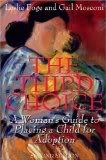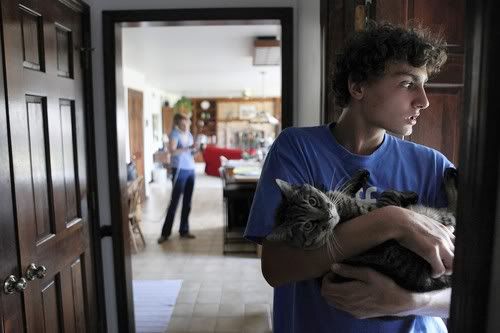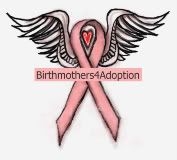This book was recommended to me by a birthmother friend, Desha.
If you are in any way involved with a domestic adoption where the birthmother chose or will choose adoption for her child, you need to read this book.
I have now read dozens of adoption books. This book, far-and-away, is the most important adoption book I have read to date.
I have now read dozens of adoption books. This book, far-and-away, is the most important adoption book I have read to date.
This book stretched me and enlarged both my place in and my understanding of the world of adoption. I will admit that as a soon-to-be adoptive mother, there were things written in this book that were difficult to read. However, as I read I became more and more aware of how important each consideration that birthmothers must make are. I realized that I wanted our baby's to-be birthmom to ask herself each of these questions and answer them honestly, because only that would lead to a healthy adoption relationship.
Table of Contents:
Introduction: An Adoption Renaissance
Preface
Chapter 1: Choosing Adoption
Chapter 2: Choosing the Right Adoption for You
Chapter 3: Finding the Right Adoptive Parents for Your Child
Chapter 4: Moving Ahead with Your Adoption Plan
Chapter 5: Your Pregnancy
Chapter 6: Hospital and Birth
Chapter 7: Grief, Loss, and Healing
Chapter 8: The First Year
Chapter 9: Beyond the First Year
Chapter 10: The other Important People: Birthfathers and Family Members
Chapter 11: Circumstances which Require Additional Thought, Planning, and Counseling
One of the most impressive features of this book are the quotes from birthmothers on each topic. These quotes range from the most positive to the most difficult. They provide a healthy spectrum and perspective. Yes, some things about your adoption experience can be great, and some may be terribly difficult. There are no rose colored glasses in this book, however, the authors (Foge and Mosconi,) adeptly illustrate the positive potential of adoption.
In each chapter the authors ask questions that expectant mothers are likely to ask, then they dive right in, answering each question in detail. They include reactions particular to the topic at hand from women who have created an adoption plan.
I will be taking this list to our meeting with our birth parents this week so that I can make sure they know anything they want to know about us and that we don't forget to ask anything important in our excitement!
Table of Contents:
Introduction: An Adoption Renaissance
Preface
Chapter 1: Choosing Adoption
Chapter 2: Choosing the Right Adoption for You
Chapter 3: Finding the Right Adoptive Parents for Your Child
Chapter 4: Moving Ahead with Your Adoption Plan
Chapter 5: Your Pregnancy
Chapter 6: Hospital and Birth
Chapter 7: Grief, Loss, and Healing
Chapter 8: The First Year
Chapter 9: Beyond the First Year
Chapter 10: The other Important People: Birthfathers and Family Members
Chapter 11: Circumstances which Require Additional Thought, Planning, and Counseling
One of the most impressive features of this book are the quotes from birthmothers on each topic. These quotes range from the most positive to the most difficult. They provide a healthy spectrum and perspective. Yes, some things about your adoption experience can be great, and some may be terribly difficult. There are no rose colored glasses in this book, however, the authors (Foge and Mosconi,) adeptly illustrate the positive potential of adoption.
In each chapter the authors ask questions that expectant mothers are likely to ask, then they dive right in, answering each question in detail. They include reactions particular to the topic at hand from women who have created an adoption plan.
"How Sure do I have to be?"Chapter three was of great interest to me, and is a great resource for all prospective adoptive parents in addition to all potential birth parents. It explains the home study process and offers suggestions on helping the expectant mom create a "birth parents wish list" (I LOVE IT!) There is also help in preparing to meet a hopeful adoptive couple and a long list of questions that should be asked by the expectant parents and questions that they should expect to be asked.
". . . It is natural to reevaluate your decision time and time again."
"This does not necessarily mean that you have made the wrong choice or that you will change your mind. It simply means that choosing adoption is a very difficult and complicated decision that , by its very nature, involves conflict."
I will be taking this list to our meeting with our birth parents this week so that I can make sure they know anything they want to know about us and that we don't forget to ask anything important in our excitement!
The last section in this chapter is entitled "Understanding the Prospective of the Adopting Parents." This is the first time that I have ever read something encouraging birth parents to consider how adoptive parents have been affected by their journey and their emotional pasts. It was surprising, healing, and enlightening. Birthmoms are loving compassionate people who make incredibly loving choices for their children. Why would I not expect them to show concern for the emotions of people that, in most cases, they hope to develop a life long relationship with?
The fourth chapter talks about how to handle the relationship with the adoptive parents in a healthy and constructive way. It has a sample Adoption Agreement to help expectant parents (and adoptive parents too) communicate about what they want the adoption to look like. Very helpful.
The next several chapters address the actual pregnancy, delivery, and beyond. They are filled with invaluable counsel for any woman who is creating a birth plan for her baby. These chapters can help a birth mom to think through everything she is going to face and prepare for the experiences and feelings that she is likely to encounter.
Some of the highlights of these chapters include:
- What a birthmom might want to pack for her hospital stay (including a letter- much like a birth plan- explaining your decision and asking for support from the medical staff.)
- Considering what kind of contact you want to have with your baby, with your friends and family, and with the adoptive couple during your hospital stay.
- Ideas for healing ways to say goodbye.
- What to do if you have a change of heart.
- What your grief may look like at various time periods after placement.
- Ideas to help accept grief and promote healing.
- How to handle confusing and conflicting emotions.
- Preparing for post-placement contact and visits.
The eleventh chapter addresses potential situations that require additional consideration, such a placing an older child, or placing with a non-traditional family.
The last and highly valuable resource in this helpful book, is a long list of additional books and resources for potential birth parents.
Let me say again that this is the most valuable book I have read on adoption to date. I feel that my perspective of adoption has changed and grown and that my understanding of a birthmom's experience has been greatly improved. This has increased my empathy and my ability to communicate with our child's birth parents in a more real and relaxed way. Thank you again, Desha, for a great recommendation.







